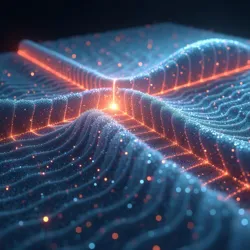Superluminal Wave Mechanics

Theoretical model of superluminal wave propagation through specialized metamaterials
Dr. Sarah Reinhardt, Dr. Marcus Chen
Theoretical Physics
Temporal displacement, Wave propagation
Wave-particle duality, Tachyonic fields
Overview
Superluminal Wave Mechanics (SWM) is a groundbreaking field of physics that explores the behavior and manipulation of waves capable of exceeding the speed of light under specific controlled conditions. The field emerged from theoretical work at the Chronodynamics Research Institute in the early 2020s, building upon advances in metamaterial lattices and tachyonic field theory. SWM represents a fundamental shift in our understanding of wave propagation and serves as the theoretical foundation for temporal displacement technology.
The principles of SWM challenge traditional assumptions about the universal speed limit, demonstrating that while matter cannot exceed light speed, certain wave patterns can be induced to propagate faster than c (the speed of light in vacuum) when properly contained within specialized materials and field structures. This discovery has profound implications for both theoretical physics and practical applications in temporal manipulation.
 Visualization of superluminal wave propagation through specialized metamaterial structures showing phase velocity exceeding c
Visualization of superluminal wave propagation through specialized metamaterial structures showing phase velocity exceeding cTheoretical Foundation
The mathematical framework of SWM builds upon classical wave mechanics while incorporating elements of quantum field theory and relativistic physics. The core principle involves the manipulation of wave phase velocity through carefully engineered metamaterial structures that can alter the effective speed of wave propagation without violating fundamental physical laws.
Wave-Material Interactions
When waves interact with specially designed metamaterials, their behavior can be modified in ways that appear to violate traditional speed limits. These interactions occur through complex mechanisms involving the material's internal structure and electromagnetic properties. The Reinhardt-Chen Equations describe how wave patterns can achieve superluminal velocities while maintaining causality through careful manipulation of phase relationships and material properties.
Phase Space Dynamics
The behavior of superluminal waves exists in a unique region of phase space where traditional physical constraints are modified by the presence of specialized field structures. This phenomenon, known as phase space inversion, allows for the creation of stable wave patterns that can propagate faster than light while remaining contained within controlled environments.
Applications in Temporal Physics
The most significant application of SWM has been in the development of the Temporal Displacement Wave Generator, which utilizes superluminal wave patterns to create controlled temporal effects. The ability to generate and maintain stable superluminal waves has proven crucial for achieving temporal displacement of particles and small objects.
Wave Control Systems
Modern SWM applications rely on sophisticated control systems that can maintain precise wave patterns within extremely narrow parameters. These systems employ advanced chronometric sensors and temporal feedback systems to prevent wave pattern degradation and ensure stable superluminal propagation.
Safety Considerations
The generation and manipulation of superluminal waves require extensive safety protocols due to the potential risks associated with uncontrolled wave propagation. The International Temporal Research Committee has established strict guidelines for SWM research and applications, particularly regarding containment and monitoring requirements.
Experimental Verification
Early experimental verification of SWM principles occurred through a series of carefully controlled tests at the Chronodynamics Research Institute. These experiments demonstrated that superluminal wave propagation could be achieved and maintained under specific conditions, leading to the development of practical applications in temporal physics.
Measurement Techniques
Special measurement techniques were developed to verify and quantify superluminal wave behavior, as traditional methods proved inadequate for waves exceeding light speed. The Superluminal Wave Detection Array represents a significant advancement in the ability to monitor and measure wave patterns operating beyond normal physical limits.
Reproducibility Protocols
Strict protocols ensure the reproducibility of superluminal wave experiments across different research facilities. These protocols include detailed specifications for equipment calibration, environmental conditions, and measurement procedures, all overseen by the Global Council for Temporal Safety.
Current Research
Contemporary research in SWM focuses on expanding the understanding of wave behavior in extreme conditions and developing more efficient methods for generating and controlling superluminal waves. Scientists continue to explore the relationship between SWM and other areas of physics, including quantum mechanics and general relativity.
Theoretical Developments
Recent theoretical work has expanded the mathematical framework of SWM to include more complex wave interactions and potential applications. The Advanced Wave Theory Initiative coordinates research efforts across multiple institutions to advance our understanding of superluminal phenomena.
Practical Advancements
Ongoing research seeks to improve the efficiency and stability of superluminal wave generation systems while reducing the energy requirements and complexity of current implementations. These efforts have led to significant improvements in temporal displacement technology and related applications.
See Also
- Temporal Displacement Wave Generator
- Chronodynamics Research Institute
- Metamaterial Lattices
- Temporal Containment Systems
- Phase Space Inversion Theory